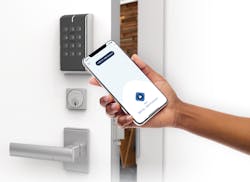Security pros trying to determine which way the winds are blowing as far as potential sales opportunities would do well to focus on three areas:
- Frictionless access control
- Workforce management
- Emerging areas
This was the advice of Mark Duato, executive vice president of Aftermarket Solutions for ASSA ABLOY Door Security Solutions, during a presentation Oct. 5, 2020, at the virtual ISC West event.
Noting how the COVID-19 pandemic has led more than 60 percent of the U.S. and Canadian workforce to work from home, “it demands a great amount of creativity and innovation to navigate this crisis,” Duato says.
The solution is a combination of new and old technology. Take frictionless access control, for example. It’s a relatively new term that means making gaining access easy while maximizing security. Increasingly, it also takes touchless control into account.
Duato notes touchless actuators as an old technology that’s aimed at part of a new frictionless solution but mentions another newer technology that security pros should consider: ultra-wideband (UWB) technology. UWB is a low-energy, short-range radio-frequency form of communication that began to appear in smartphones in 2019, and Duato says it can be deployed to improve access control functionality.
“We can now understand that a credential holder walking by a secure opening is different from a credential holder who is approaching the opening with the intent to enter,” he says. “These differences, as UWB is more broadly deployed, will avoid compromising security and provide benefits to the end user.”
Two other technologies that will be a significant part of this push for frictionless access control should come as no surprise — smartphones and wireless hardware. The latter is necessary, Duato says, “to bring access control deeper into a facility in a cost-effective way.” In other words, it’s way less expensive than a wired system (as well as easier to install).
As for workforce management in the aftermath of the pandemic, that term has several potential ramifications. There’s the desire to be able to control how many people are in close quarters, such as by proximity monitoring to try to maximize safety, but the workspace itself might be affected. Duato mentions locker management for a transitory workforce as an example.
“For those who come in a few days per week, they may need the ability to place belongings into secure places, a locker of some sort,” Duato says. Businesses would have to be able to create and change access credentials to these lockers in “a fast way.” How? Through smartphones and wireless locks.
With respect to emerging areas that will demand attention, Duato names unmanned critical infrastructure, such as remote traffic management, as one of three key applications because of the number of such sites that aren’t as secure as they could be. The others are intelligent power supplies and untraditional openings, such as data centers.
Seemingly in anticipation of this thrust, ASSA ABLOY introduced its Safer2Open suite of access control solutions in late September. The suite brings together products ranging from low-touch arm pulls to exit motion sensors.
More products aimed at achieving wider spread access control are coming, Duato says, but it’s difficult to project ultimately what form they will take, because in many applications, such as hospitals or schools, the new products must be code-compliant.
“The standards for codes and compliance will continue to evolve and change,” he says. “Some of those [solutions] have yet to emerge.”
Stay tuned.
About the Author
Will Christensen
Senior Editor
Will Christensen is senior editor at Locksmith Ledger International. He has been an editor and reporter at magazines and newspapers for more than 30 years.
